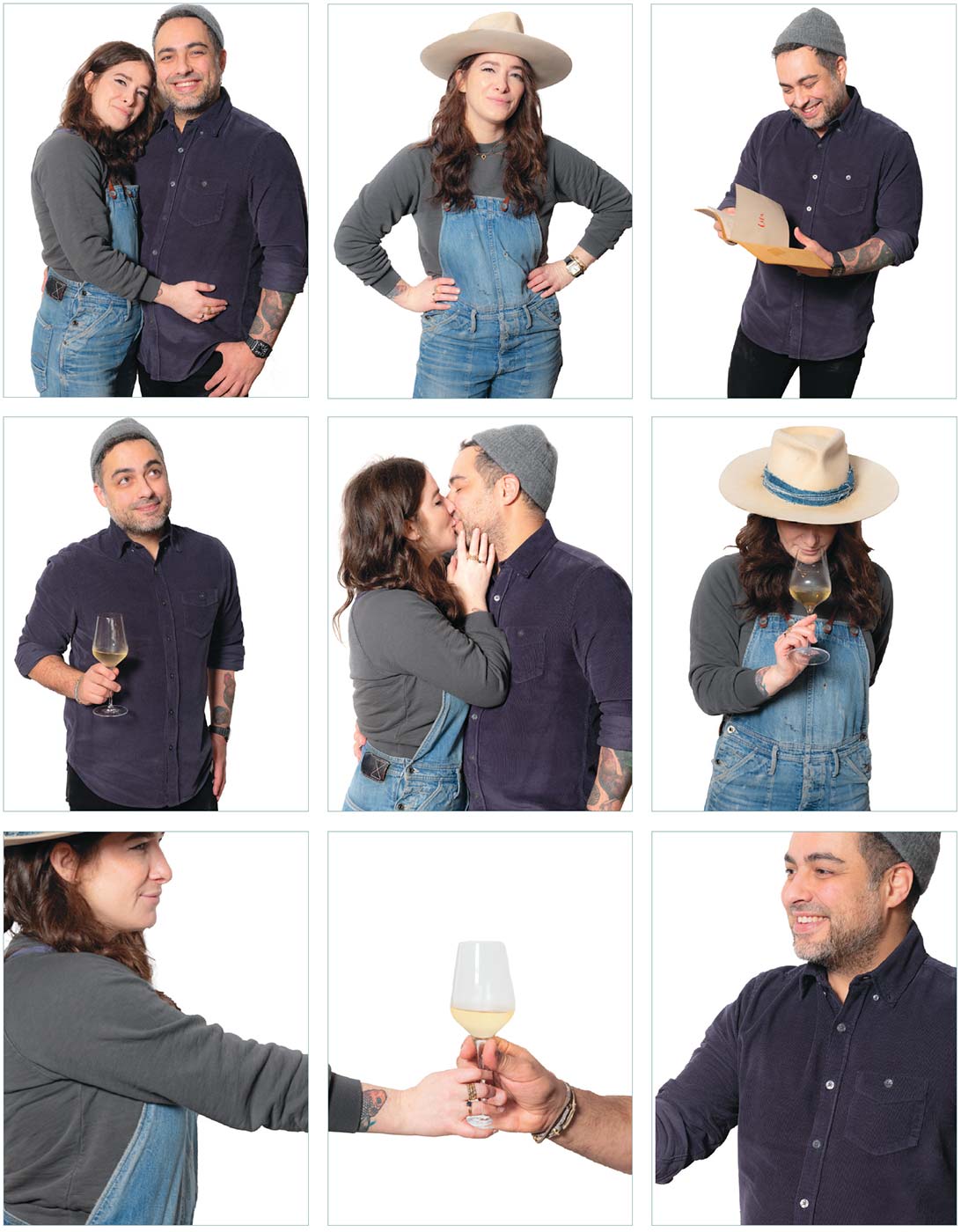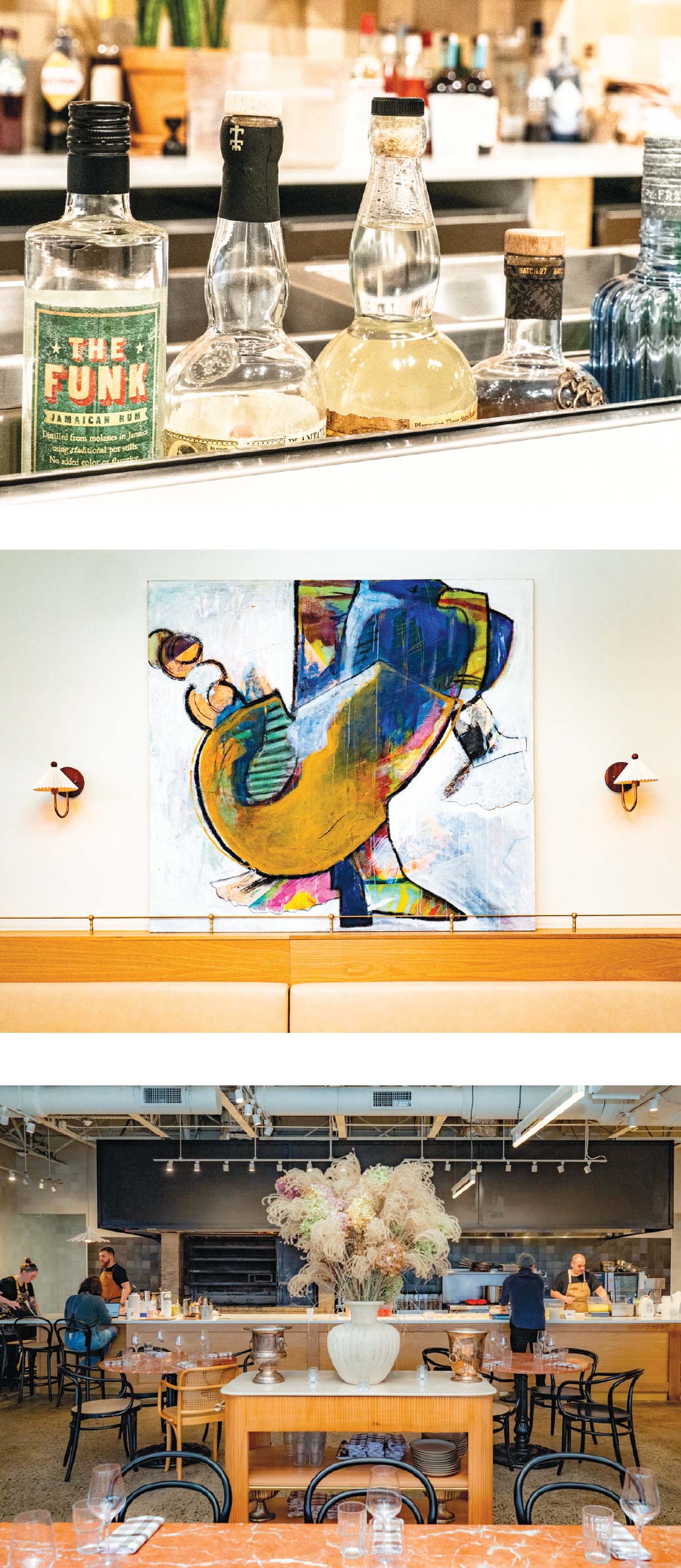Q&A with Neilly Robinson and David Viana

“IT WAS THE FIRST TIME I WAS WORKING WITH SOMEONE WHO COMPLETELY TRUSTED ME.IT FELT DIFFERENT. IT GAVE ME COURAGE AND BALANCE.”
When Neilly Robinson and David Viana agreed to partner in 2016, each had been considering a different path altogether. In 2013, Robinson and her mother had opened Heirloom Kitchen, a cooking school and retail boutique in Old Bridge, soon recognized by Food & Wine as one of the best cooking schools in the country. Viana had worked for several notable chefs and restaurants and had received high marks as executive chef at The Kitchen at Grove Station in Jersey City.
They were familiar with one another, since Viana had guested at Heir-loom. Both were questioning their next move in the industry, or out of it, as neither felt they were advancing professionally. Then—in Robin-son’s words, after “an idea, a Negroni, a walk-through, and a hand-shake”—they agreed to open the restaurant and supper club portion of Heirloom Kitchen.
Since then, Viana has appeared on “Top Chef” and gotten a James Beard Award nomination. In 2022, they launched a new venture in Asbury Park—Heirloom at the St. Laurent—which created an elevated food and beverage experience as part of a resort and private club in an already popular dining destination town. In 2023, they introduced Lita in Aberdeen, which was heralded within months of opening as one of the best new restaurants in the country by Esquire, and where this conversation took place.
Today, when many similar businesses are struggling to stay afloat or have closed altogether, their partnership is thriving, professionally and personally. In conversation with Robinson and Viana, you can tell there is a seamless level of connection and care for their customers, their staff, and for each other. Their eyes are on moving forward not just their partnership, but the industry.
Three successful and highly regarded restaurants in a most challenging time for the industry, but seven years ago you both found yourselves at professional crossroads and ended up on the same corner. What was happening?
NEILLY ROBINSON: I’d been open for three years [at Heirloom Kitchen] with my mother. We were a niche business and built a loyal community, but we were quiet. I wasn’t paying myself and I didn’t know what I was going to do next. I just knew I couldn’t work for someone else. David had been a guest teacher at the cooking school, so I knew he was super talented and there wasn’t a ton of opportunity in the general area we were located in. I thought maybe he’d say yes to joining our kitchen.
DAVID VIANA: After 17 years, I was at the end of my rope and thinking of quitting. I had a newborn to factor in and felt I had nothing to show for the work I had put in. Neilly came up with the idea to turn her little boutique-school-shop into a supper club. Three nights of dinner service, three nights of classes sounded like the least arduous position I’d ever been offered, providing the most balance I could ever find. I really wanted to collaborate with her. Loved her, loved her store, her taste level. I thought she was very talented and thought the business model was interesting. The social media presence was multifaceted in a way I had seen the industry going in but with very few having the ability to do it. I thought “Let me do this one last time. At the least I’ll get some really interesting photos out of it!” (laughter)
Each of you brought different skill sets that have obviously melded on multiple levels. Did it happen quickly?
DV: Very quickly. We highlight and complement one another in so many aspects.
NR: The secret sauce to us doing great things was in having full trust with what each of us was doing and bringing to the table. It was easy. We weren’t butting heads.
DV: It was the first time I was working with someone who completely trusted me. It felt different. It gave me courage and balance. Made me much more cerebral and gave me time to think and rethink. To be purposeful and intentional. She allowed me to be the best version of me at the right time and place. She was and is the best partner for me.
NR: All of that. All of those sentiments apply to me too. We are partners in business and in life.

“OUR INTENTIONS WERE TO CREATE BALANCE. EQUALIZE THE FOH AND BOH, FIX THE BROKEN RESTAURANT MODEL, REDISTRIBUTE MONEY WHERE IT SHOULD BE. THOSE ARE OUR DRIVERS.”
The setup at Heirloom is different. Dining there felt like a television show set, which is part of your story. It gave you two things you had not had before. Let’s discuss the first—a new perspective.
NR: The kitchen was built for demos with the range in the center, so chefs were facing the class. Hibachi 2.0, I called it, with little opportunity to turn away from the guests.
DV: It is where I got my appreciation for hospitality. I grew up wanting to be a chef, but never thought of the industry. I was focused on food alone. I really did appreciate a whole new level of what I did for a living after seeing people enjoy their food: their joy, the high when leaving after dinner, the smiles when they walked out the door. I was not as solely focused on the dish and what I wanted it to look like. And yes, a “Top Chef” casting person was dining one night, and I was asked to be on the show. You never know who you are cooking for.
The second thing you gained from Heirloom was time, and that time led to what you are doing here at Lita, and your overall approach to three properties with distinct personalities.
DV: A lot of things started at Heirloom. Our schedule gave me time. I was saying on “Top Chef” there was a need for balance and changing how the industry worked, and people would laugh and roll their eyes. Then the pandemic happened, and everyone started saying the same exact thing I had been saying. People are now listening and talking about it, but I had the time before to really consider this. Stopping and thinking will forever now be a part of my life.
So the model you have implemented at Lita was not an invention born out of necessity brought on by challenges and changes in the industry since the pandemic.
NR: Our concept of “Hospitality Professionals” is David’s baby, this utopian thing happening, breaking down walls between the front of the house (FOH) and back of the house (BOH), where all roles are interchangeable. Teaching people there is so much more to cooking than putting your head down and chopping something on a cutting board. A lot of cooks are not taught that, not given the exposure to know what it means to be hospitable, and to learn how a business runs from all aspects. That’s what’s happening here: an educational center for cooks who want to do this the rest of their lives.
DV: Knowing the traditional restaurant model was broken, I have been searching in my mind for ways to address it. So many moments the industry has tried to address inequities we know are happening but had no way to really do so. I came up with the idea to only hire chefs and have two teams [at Lita], working one week in the dining room, one week in the kitchen, and every week they exchange places.
The idea made a lot of sense in my head, so I started talking to my peers and other professionals. I wanted to see how many holes people could poke through it. I fleshed out the idea in my head and didn’t see a reason why it wouldn’t work.

Scenes from Lita
The industry is traditional and hierarchical, and a lot of people don’t want change or feel as if they may lose control.
NR: There was a lot of skepticism because it’s a transient workforce and also because of the perception that cooks are in the kitchen because they don’t like to talk to people or have customer contact. The #1 response was, “How do you get people who don’t want to be guest-facing to be guest-facing. And where are you going to find that many chefs?”
The takeaway is, the industry seems so much harder, people aren’t as healthy, not as happy, need more money, and this is the time to focus on this business we love in a meaningful manner. Our intentions were to create balance. Equalize the FOH and BOH, fix the broken restaurant model, redistribute money where it should be. Those are our drivers. When you have those good intentions, everything else becomes a benefit of that. That is what is happening in this building.
The challenge was not in the hiring or in the current day-to-day operations, but starting up.
DV: Training was the hardest because the first week happened twice, since we flipped schedules every week.
It was like Groundhog Day! Six weeks in is usually the sweet spot for a new restaurant to get its feet underneath it; ours was three months because we doubled the opening process. It was the hardest opening of my life, but the most rewarding restaurant experience now. We are a more stable organization, more of an impenetrable force than any other I have been in. We have the ability to put out every fire like that (snap). It was worth the struggle and pain and change in building a new model. We will do it again.
What has the upside been?
NR: From a staffing standpoint, we always have someone in the building we can move if someone calls out and shift everyone around. We have an experienced person available at all positions. On a larger scale, everyone truly understands every problem you experience. Everything comes full circle.
DV: Conversations are happening with a lot more grace. No one gets mad because there is a broader understanding. That’s what I am going to love: when they all become chefs elsewhere someday and will talk more constructively and treat it in is an educational manner. The other thing I love is talking to a group of people who are invested. No part-timers; every conversation is with someone fully invested in the success of this restaurant. To see this place be better and successful. And everyone earning a living wage.
No matter what, our team will be that much better because they will have every perspective of every role in their arsenal; talk more eloquently about service and create better cultures in restaurants.
NR: It teaches what it takes to run a business. Every cook thinks they want to do this and it’s really difficult.
The food and wine at Lita ... why Iberian?
DV: My first language is Portuguese. I am Elizabeth (NJ) born and raised, with 15 members of my extended family living on the same block. Sheltering during the pandemic, I got nostalgic and [it] got me cooking my grandmother’s recipes. I realized a sense of pride in what we were making at home was missing, and I wanted that to be the story of Portuguese food going forward in New Jersey.
You are taking classic recipes and methods, like cooking over coal, and upscaling them, putting your own spin on it. It’s gone well enough since you were named one of the top new restaurants in the country by Esquire. What have you done differently and how has the feedback been?
DV: My favorite story so far: I had a Portuguese woman who wanted to speak with me about her dining experience. She first corrected the spelling on the menu. I was deathly afraid at that moment about what was next! (laughter) She then told me I plated everything wrong, and the food didn’t look recognizable, but when she took a bite, it tasted exactly like back home in Portugal. It couldn’t have been a more perfect compliment.
What’s next?
DV: I don’t know. Osteria Heirloom maybe?
Italian is de facto in Jersey.
NR: We’re good right now! (laughter)
I’d say really good.

LITA
1055 Route 34, Aberdeen
732.696.8517
thelovelylita.com
HEIRLOOM AT THE ST. LAURENT
408 7th Ave., Asbury Park
732.795.2582
thestlaurent.com
HEIRLOOM KITCHEN RESTAURANT & COOKING SCHOOL
3853 Highway 516, Old Bridge
732.727.9444
heirloomkitchen.com



